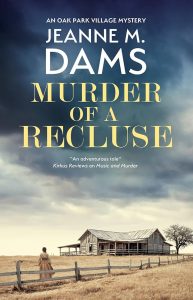Oak Park Village #3
 I read the first book in this series, Murder in the Park, when it came out in 2021. It stuck in my head, and when I picked up the latest book four years later, the place and characters came back to me right away. Set in a Chicago suburb in the 20’s, the books follow now new bride Elizabeth Wilkins. She’s separated herself at last from a difficult and controlling mother and is finding life as a young bride very pleasant. She and her husband are building a house and are making space for his Aunt Lucy in their new home.
I read the first book in this series, Murder in the Park, when it came out in 2021. It stuck in my head, and when I picked up the latest book four years later, the place and characters came back to me right away. Set in a Chicago suburb in the 20’s, the books follow now new bride Elizabeth Wilkins. She’s separated herself at last from a difficult and controlling mother and is finding life as a young bride very pleasant. She and her husband are building a house and are making space for his Aunt Lucy in their new home.
Aunt Lucy has served basically as a mother to her husband Fred, a lawyer, and Elizabeth loves her as much as Fred does. The two of them step up when Fred is flummoxed by a new client: Caroline Dobbs, who is accused of murdering her cranky Aunt Agatha, who lived alone in squalor. While there’s no direct evidence, a neighbor had come by the house shortly after Caroline’s departure to discover Agatha’s body. Fred is convinced of Caroline’s imminent arrest.
The case rests on hearsay. And what Elizabeth can provide to Fred is basically hearsay, in the form of women’s talk to one another. In her effort to find out information, she joins the prestigious Nineteenth Century Women’s Club to access the network of connections provided by the wives of judges and politicians and prominent society figures. Whenever she turns up a bit of a lead, Fred then sets his investigator on it. Between them, they discover the truth of the case.
The mystery part of this is well set up and thought out, but what shines are the characters. Elizabeth is a young woman finding herself, learning to stand up to her mother, and setting up her own household. Caroline, the accused woman, is just as fascinating. She’s reluctant to talk but with Elizabeth’s persistently gentle interrogation she does begin to share a bit of information. Some of it is revealed as the two women clear Aunt Agatha’s home which is filled with junk, as is Caroline’s own dusty home.
Elizabeth and Lucy have also made friends – via the age old method of fresh cookies – with some of Al Capone’s men who are camped out in Oak Park. She met Capone in the last outing and this different network is also a help to Elizabeth and Lucy as they continue their questioning of many of the town’s residents.
Dams really gives the reader a good feel for what life in 1926 might have been like. While Oak Park would now be considered a suburb, in 1926 it was a village near Chicago with its own identity. Elizabeth draws on her knowledge of the community as she conducts her investigation, something that wouldn’t be so easy in a big city like Chicago.
This was a pleasant read with characters I was happy to meet up with again, and I enjoyed the rhythm of Elizabeth’s life. Dams made me feel like I was a part of it as I read, no small feat on her part. This author’s work remains solid and consistently readable, and I am so appreciative of her decades of writing, which now includes over thirty five novels. — Robin Agnew